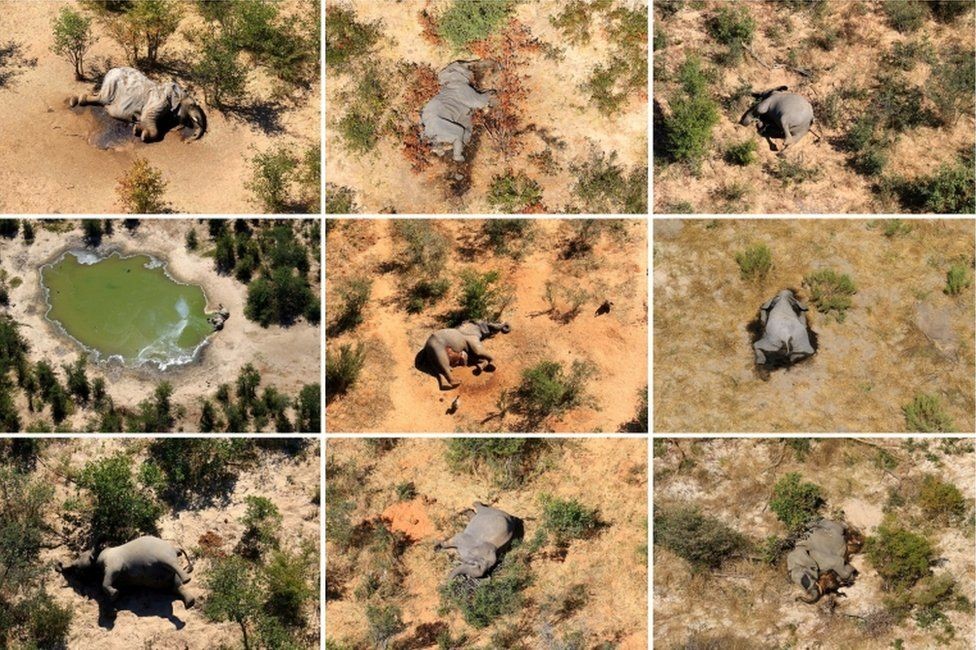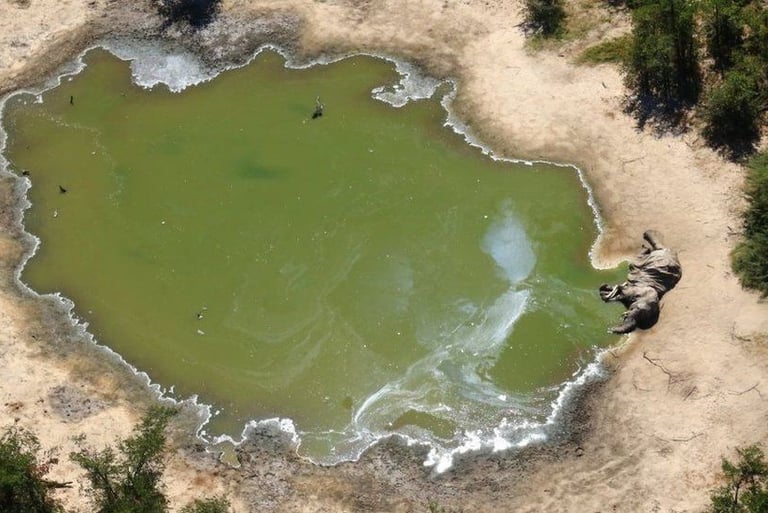
Diseased or Hunted: Who Killed the Elephant in the Room?


My post content
Mysterious Mass Die-offs in Botswana
Africa will be hardest hit by climate change but is contributing the least to causing these changes. As a whole, it is responsible for less than 4% of the world's greenhouse gas emissions. Africa’s efforts of wildlife conservation are at risk with increasing human pressure on biodiversity. Botswana’s ongoing human-elephant conflict was in the news in 2020 for the deaths of more than 350 elephants along the Okavango Delta from an unknown cause leaving us apprehensive about these deaths. About 70% of the deaths happened around water holes although these waterholes were filled with water and such mass die-offs were seen only in case of droughts earlier. Eyewitnesses have reported that these elephants died by simply dropping on their faces while sometimes they were seen walking around in circles, indicative of some neurological issue. During investigations authorities had ruled out poaching as the cause of death as tusks were not removed and waterholes were not found poisoned by locals. Conservationists have pointed these deaths to a rodent virus known as EMC (encephalomyocarditis) and to toxins from algae blooms in the waterholes, although these theories need testing backups. Testing by authorities has reported cyanobacterial neurotoxins behind these deaths which leaves us with many questions such as why only elephants were dying and why only the Delta area.
The ad-hocism to deal with coexistence and conservation is in question with these mass die-offs. The cause of these deaths can only be human-induced whether knowingly or unknowingly. Now the question is if the cause-effect relationship of human activities was known or not known to the authorities responsible and accountable to both their subjects i.e. animals and humans. In this article, we will be looking into various aspects linking the cause of elephant deaths from all the dimensions ranging from socio-political and economic to environmental.
Human-Wildlife Conflict
Elephants are not only the largest mammals living with us but they are the wisest ecosystem engineers supporting our survival. They are a keystone species playing a vital role in maintaining the balance of ecosystems. One of the major threats to elephants is poaching for their ivory tusks which have caused a significant decline in the elephant population in recent years. Poaching has been defined by authorities as the illegal hunting or capturing of wild animals, associating it with land use rights. Research related to mass extinction has identified elephants at risk of extinction due to human activities. Climate change is a common threat they are facing apart from the ongoing destruction of their habitats due to human-elephant conflict.


#Socio-Ecological Dimension: Burning the ‘Library of Life’ along with Indigenous Bushmen and Biodiversity of Botswana
Geography of Botswana
Botswana is home to around 140,000 elephants (one-third of Africa’s total) with a human population of 2,024,904 (census 2011) sharing an area of 581,730 sq. km. The semi-arid Kalahari Desert covers about 70% of Botswana's surface in the center and south. In the north is the seasonal Okavango Delta which is a World Heritage Site and one of the world's largest inland deltas flowing into Botswana from the Angolan highlands. It spans about 15,000 sq. km. and is relatively flat. The Okavango Delta is an oasis of lagoons and channels amidst a fan of islands, sands, reeds, grasslands, palms, and Mopane forests. The Makgadikgadi Pans are located in the north-west section of Botswana where lies the Tsodilo Hills, a series of large rock formations which is another World Heritage Site known as "the mountains of the gods" considered holy for Sans people as they believe their ancestral spirits reside there. These hills have more than 4,500 rock paintings dating back to 20,000 years and preserving the history of the Sans people.
Indigenous Bushmen
Botswana along with the southern African continent is home to 100,000 Bushmen, an indigenous people of southern Africa who have lived there for tens of thousands of years. They were the first nation in the whole of the southern African continent. In 2017, Botswana was home to approximately 63,500 San people one of the African Bushmen Tribes, which is roughly 2.8% of the country's population, making it the country with the highest population of San people. In order to provide protection to indigenous communities and flora & fauna, the Central Kalahari Game Reserve was created in 1961, during the last days of British colonial rule, that covers an area of 52,800 sq. km. approximately 10% of Botswana’s total area.
Soon after independence, the government started a campaign to relocate Bushmen by justifying that their overhunting posed threat to wildlife in the 1970s. With the sudden discovery of the largest diamond deposits in the early 1980s, the Bushmen were evicted from their ancestral lands. This left them with no choice but to walk in the country’s court for justice from the government. This ongoing battle continued until 2006 when the court gave them rights to go back to their land. It's an ongoing battle since the government made it impossible for them to survive in the reserve area by covering their waterholes and banning hunting from time to time starving them.
AIDS Epidemic
Life expectancy in Botswana stood at 65 years in 1990, it was estimated to have fallen to 57 by 1997 and to just 35 in 2005. However, after the 2011 census life expectancy was revised upwards to 54.5 years. With the first case appearance of HIV/AIDS in 1985 it has become the biggest threat to the developmental achievements of Botswana's government since independence in 1966. According to UNAIDS, an estimated 380,000 people were living with HIV in 2017. Botswana has committed to ending the AIDS epidemic as a public health threat by 2030.
Indigenous people and wildlife have been always destroyed by colonial policies and their younger generations have been pushed towards alcoholism, depression, and illnesses such as TB and HIV/AIDS as in the case of Botswana’s Bushmen. All hope is lost from profit-savvy governments who have not cared for people, and will ever care for animals. But humanity has faith in people who are voicing their concerns for the elephants so that they are not treated and pushed out from their habitat like in the case of Bushmen in Botswana.
#Economic Dimension: DeBeers Diamond Empire
Debswana is the diamond mining corporation owned jointly by the government and DeBeers where the Botswana government owns only 15% of the shares. While in 2011, 40% of shares were sold by the Oppenheimer family to Anglo American Plc in £3.2 billion (US$5.1 billion) in cash and ended the Oppenheimer dynasty's 80-year ownership of De Beers, thus making AAC the 85% shareholder in Debswana. Debswana operates four diamond mines in Orapa, Letlhakane, Damtshaa, and Jwaneng employing about 6,500 people or just 2% of the workforce. Botswana's workforce is being depleted as many productive adults develop AIDS and are no longer able to work.
Wildlife Tourism & Conservation
Tourism from wildlife is the second biggest earner for Botswana after diamonds. Since the construction sector is dominated by Chinese firms, the telecom sector is dominated by Portuguese, and the retail sector is dominated by Asian, aboriginals are left with the formal sector of tourism which is also mostly dominated by descendants of colonialists.
Growing resentment toward the animals among farmers in Botswana is upending the country’s politics and prompting the reversal of policies that turned tourism into Botswana’s second-biggest earner after diamonds. The furor has also spilled into a larger debate over race in a country where white foreigners and the descendants of colonialists control much of the conservation and tourism sectors while many who live outside the national parks eke out a living on government subsidies
#Political Dimension: Human-Elephant Conflict became an Electoral Agenda for 2019 Presidential Election
Since its independence in 1966 from Britain, this country has been ruled by only one political party, the Botswana Democratic Party (BDP) although it is a multiparty, constitutional, and democratic nation. Since Botswana law restricts the president to serving two five-year terms and provides for the vice president to automatically fill the post should it become vacant. So President Ian Khama stepped down on 31 March 2018 exactly a decade to the day after he became president of Botswana to make way for his vice president, and the then Vice President Mokgweetsi Masisi took his place.
The very controversial trophy hunting ban was lifted on 23 May 2019 by the elected President Mokgweetsi Masisi 2019 which was banned by former President Ian Khama in 2014 and was welcomed by the public according to the media. Human-elephant conflict in Botswana has been a major issue in the general election held on 23 October 2019. The hunting ban was lifted to please the farmers dealing with tramping and attacks of elephants.
Trophy hunting is not a solution to the human-animal conflict or population control of elephants, in fact, it exacerbates this conflict in a way that coexistence is becoming a far dream. This is not sustainable for both communities to thrive. The government and people talking about coexistence and conservation have to target the mining giants profiting from the geological resources of Africa. Already it is too late to question the rights of indigenous people, now the question has come to everyone’s survival.
Mining is responsible for such conservation disasters affecting the ecosystems and inducing climate change at a faster pace. Climate Change is the mask that the mining industry wears to cover their lack of effort in restoring spoiled ecosystems. We as people need to question the causes of climate change before it reaches our waters.
